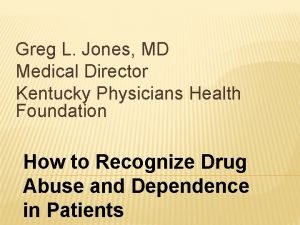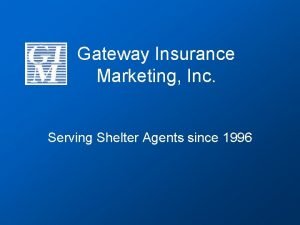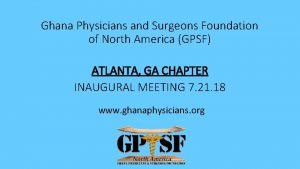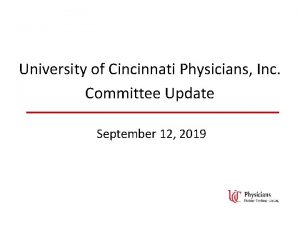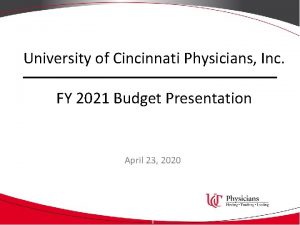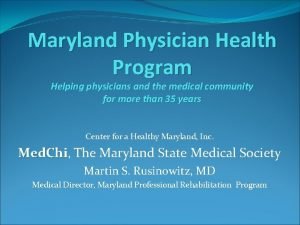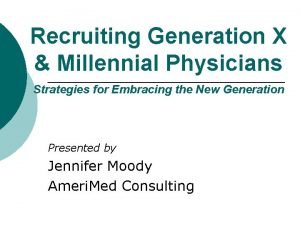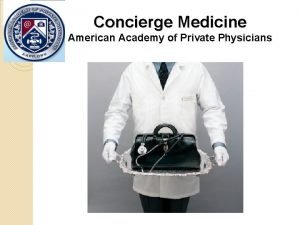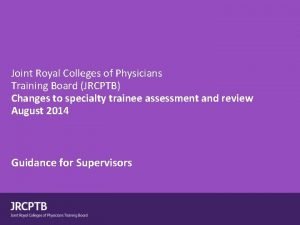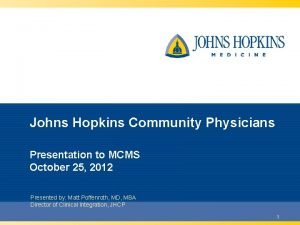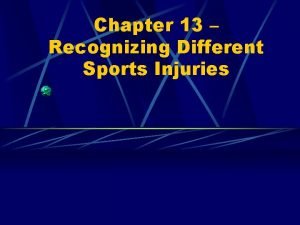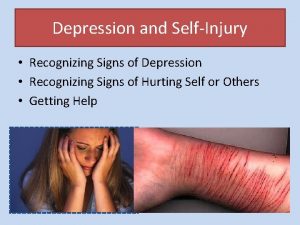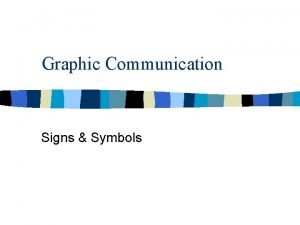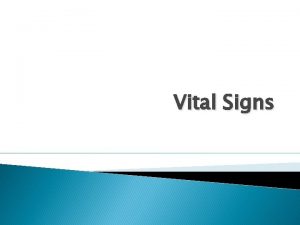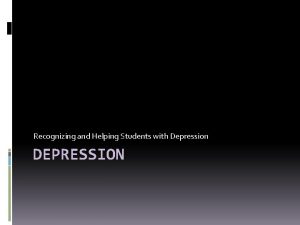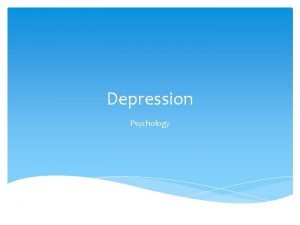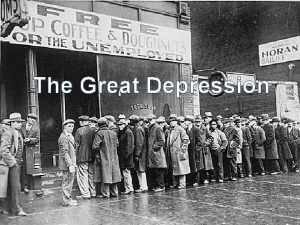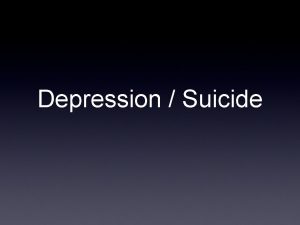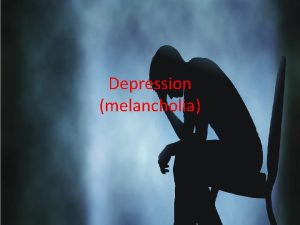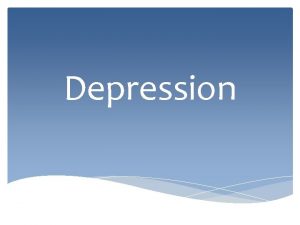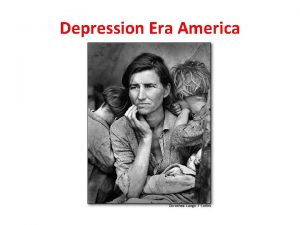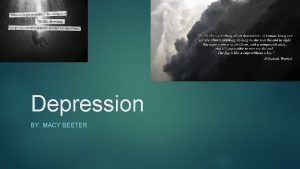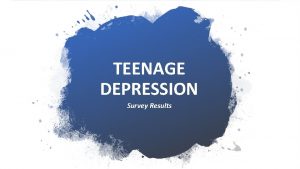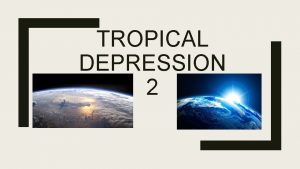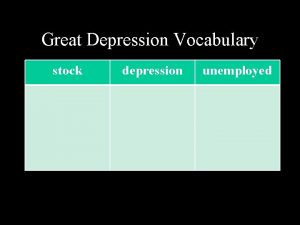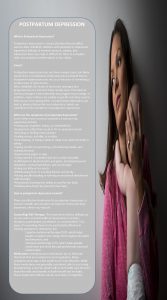Recognizing the Signs of Depression in Physicians Version





















- Slides: 21

Recognizing the Signs of Depression in Physicians Version 1. 0: Updated June 2020

How to use the WELL Toolkit slides These slide decks were created by the WELL Toolkit Workgroup in 2020. You may use these slides individually or as a set for non-commercial purposes. You are welcome to edit this slide deck to customize it to your setting, including the use of your own logo, but please do not substantively change the content of the work. If you present, reproduce, or distribute these slides, please acknowledge our resource, “WELL Toolkit (2020). ” For additional information and related resources, please visit: https: //gmewellness. upmc. com/

Agenda • Definition of Depression • Physician-specific risk factors • Signs and symptoms • How to help

Learning Objectives 1. Know the signs and symptoms of depression 2. Be aware of the factors that make physicians at increased risk for depressive episodes 3. Feel confident in knowing how to be the one to help a colleague who is showing signs of depression

Physicians Connected https: //www. youtube. com/watch? reload=9&v=Xtfsrqp 9 XH 4

Diagnostic Criteria for Major Depressive Disorder (MDD) At least 5 of the following symptoms have to have been present during the same 2 -week period (and at least 1 of the symptoms must be diminished interest/pleasure or depressed mood): q q q q q Depressed mood Loss of pleasure or interest (anhedonia) Weight change or appetite disturbance Sleep disturbance (insomnia or hypersomnia) Psychomotor agitation or retardation Fatigue or loss of energy Feelings of worthlessness Diminished ability to concentrate Recurrent thoughts of death or suicide

Major Depressive Disorder (continued) • The symptoms cause significant distress or impairment in social, occupational or other important areas of functioning. • The symptoms are not attributable to the physiological effects of a substance (e. g. , a drug of abuse, a medication) or another medical condition. • The disturbance is not better explained by a persistent schizoaffective disorder, schizophrenia, delusional disorder, or other specified or unspecified schizophrenia spectrum and other psychotic disorders • There has never been a manic episode or a hypomanic episode

Epidemiology Estimated prevalence of depression in physicians exceeds rates in the general population: • 12% of male physicians • 19. 5% of female physicians • 15 -30% among medical trainees (Medscape 2018)

Screening for Depression • The Patient Health Questionnaire (PHQ-9) is an evidence-based screening tool for depression (with 88% diagnostic sensitivity and specificity). • There are free online PHQ-9 calculators such as: https: //www. mdcalc. com/phq-9 patient-health-questionnaire-9 • There also free PDF versions in >30 languages online at: https: //www. phqscreeners. com

Unique Stressors Physicians have unique work-related stressors: • Acute stressors (e. g. patient deaths, medical error, job insecurity, patient and/or system dissatisfaction, license restrictions, malpractice lawsuits) • Chronic stressors (e. g. difficulty unplugging from job, workload compression, professional isolation)

Factors Associated with Increased Depressive Symptoms in Residents • • • • Burnout Social isolation Long work hours Poor sleep schedule and fatigue Lack of control (e. g. schedule, hours, workload) History of depression, anxiety, SI, or trauma Substance use Inadequate feedback Experiencing patient deaths Poor inpatient learning experiences Feeling mistreated at work In the process of or history of being sued Restrictions on license High institutional research rankings Stressors outside work (e. g. finances, relationship, health) https: //journals. lww. com/academicmedicine/Abstract/publishahead/Residency_Program_Factors_Associated_with. 97753. aspx

When to be Concerned: Changes in Work Performance • • • Change in punctuality Delayed response to pages/phone calls Failure to complete required tasks Poor participation in work activities Change in “professionalism” Poor eye contact Poor patient care Work-family conflict Increased frequency of medical errors Sudden change in patient satisfaction scores

Beware that performance at work for physicians is often the last thing to go. Professionals often function relatively well until depression is severe!

When to be Concerned: Other Signs & Symptoms • Mood Changes: Sad or depressed mood, hopelessness, irritability, humiliation, guilt, anxiety, rage, etc. • Concerning Statements: for example, “I’m a burden to others”, “I feel trapped”, “this is unbearable, ” “I have no reason to live” • Concerning Behaviors: Recklessness, withdrawing from others and activities, decreased engagement, isolating self from family and friends, change in sleep habits, aggression, increased drug or alcohol use, etc. https: //afsp. org/about-suicide/risk-factors-and-warning-signs https: //osteopathic. org/life-career/do-well-toolkit/physician-depression

There may not always be overt signs of depression, so it is important to ASK how others are doing if you are concerned.

Starting the conversation You might feel uneasy about starting a conversation where you are expressing concern for another physician. The likelihood is, however, your colleague will feel grateful that you cared enough to ask. Instead of “How are you? ” Perhaps try: • “You don’t seem yourself. How can I help? ” • “I have to be honest, I’ve been concerned about you lately. ” • “What was today like for you? What brought you joy? Did anything derail you?

Ad Council. Seize the Awkward. https: //seizetheawkward. org/

Keep the conversation going Now that you’ve established that you’re interested in helping, there a variety of ways to continue the conversation. Sample language could include: Validate: • “We physicians are really good at taking care of others, but not always the best at seeking help for ourselves. ” Inform: • “Seeking help can be confidential and doesn’t have to impact your practice [or training]. ” Normalize: • “I’ve talked to somebody about my own problems, and it really helped. ”

And Remember: Asking about suicide does not increase the risk of suicide. (Gould, 2005)

PLEASE refer to the following WELL Toolkit resources for more details: INTRODUCTION q. Tips for Supervisors (pdf) q. How to decrease barriers to physician help-seeking (ppt) q. UPMC Well-Being Resources – Resident and Attending Versions (pdf) q. UPMC Guide on what happens when a physician seeks help (ppt) SUICIDE SECTION q. Physician Suicide Prevention (ppt) q. Physician Suicide FAQ (pdf)

For more information: Thank you! The WELL Website https: //gmewellness. upmc. com Please email questions to: Sansea Jacobson, M. D. jacobsonsl@upmc. edu Vu Nguyen, M. D. nguyenvt 3@upmc. edu
 Sign shapes meaning
Sign shapes meaning The diamond shape is used exclusively for _____ signs.
The diamond shape is used exclusively for _____ signs. Natural and conventional signs in semantics
Natural and conventional signs in semantics Railroad signs and meanings
Railroad signs and meanings Kentucky physicians health foundation
Kentucky physicians health foundation Physicians mutual gateway
Physicians mutual gateway Group 1 vs group 2 specialties
Group 1 vs group 2 specialties Ghana physicians and surgeons foundation
Ghana physicians and surgeons foundation University of cincinnati physicians inc
University of cincinnati physicians inc University of cincinnati physicians inc
University of cincinnati physicians inc Wvmc mychart
Wvmc mychart Colorado physicians health program
Colorado physicians health program Primary care physician wellstar
Primary care physician wellstar Recruiting millennial physicians
Recruiting millennial physicians Griffin concierge medical cost
Griffin concierge medical cost Msf jrcptb
Msf jrcptb Johns hopkins community physicians
Johns hopkins community physicians Personal pronouns
Personal pronouns Chapter 3 recognizing opportunity
Chapter 3 recognizing opportunity Process of channel design
Process of channel design Recognizing a firm's intellectual assets
Recognizing a firm's intellectual assets Chapter 13 worksheet recognizing different sports injuries
Chapter 13 worksheet recognizing different sports injuries




